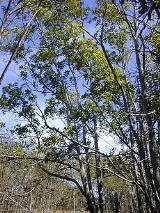
Acacia mangium
Encyclopedia
Acacia mangium is a species of flowering
tree
in the pea
family, Fabaceae
, that is native to northeastern Queensland
in Australia
, the Western Province
of Papua New Guinea
, Papua
, and the eastern Maluku Islands
. Common names include Black Wattle, Hickory Wattle and Mangium. Its uses include environmental management and wood.Acacia mangium grows up to 30 metres (98.4 ft) tall, often with a straight trunk. This tree is widely used in Goa in the mining industry for rehabilitation of the waste dumps as it is a drought resistant species and binds the sterile mine waste consisting of lateritic
strata. Like many other legumes, it is able to fix nitrogen in the soil. Acacia mangium has about 142,000 seeds/kg.
. The sugar composition after hydrolysis: 9.0% 4-0-methylglucuronic acid, 23.2% glucuronic acid
, 56% galactose
, 10% arabinose
, and 2% rhamnose
.
Flowering plant
The flowering plants , also known as Angiospermae or Magnoliophyta, are the most diverse group of land plants. Angiosperms are seed-producing plants like the gymnosperms and can be distinguished from the gymnosperms by a series of synapomorphies...
tree
Tree
A tree is a perennial woody plant. It is most often defined as a woody plant that has many secondary branches supported clear of the ground on a single main stem or trunk with clear apical dominance. A minimum height specification at maturity is cited by some authors, varying from 3 m to...
in the pea
Pea
A pea is most commonly the small spherical seed or the seed-pod of the pod fruit Pisum sativum. Each pod contains several peas. Peapods are botanically a fruit, since they contain seeds developed from the ovary of a flower. However, peas are considered to be a vegetable in cooking...
family, Fabaceae
Fabaceae
The Fabaceae or Leguminosae, commonly known as the legume, pea, or bean family, is a large and economically important family of flowering plants. The group is the third largest land plant family, behind only the Orchidaceae and Asteraceae, with 730 genera and over 19,400 species...
, that is native to northeastern Queensland
Queensland
Queensland is a state of Australia, occupying the north-eastern section of the mainland continent. It is bordered by the Northern Territory, South Australia and New South Wales to the west, south-west and south respectively. To the east, Queensland is bordered by the Coral Sea and Pacific Ocean...
in Australia
Australia
Australia , officially the Commonwealth of Australia, is a country in the Southern Hemisphere comprising the mainland of the Australian continent, the island of Tasmania, and numerous smaller islands in the Indian and Pacific Oceans. It is the world's sixth-largest country by total area...
, the Western Province
Western Province (Papua New Guinea)
Western Province is a coastal province in southwestern Papua New Guinea, bordering the Indonesian province of Papua. The provincial capital is Daru, on the island of Daru. The largest town in the province is Tabubil...
of Papua New Guinea
Papua New Guinea
Papua New Guinea , officially the Independent State of Papua New Guinea, is a country in Oceania, occupying the eastern half of the island of New Guinea and numerous offshore islands...
, Papua
Papua (Indonesian province)
Papua comprises most of the western half of the island of New Guinea and nearby islands. Its capital is Jayapura. It's the largest and easternmost province of Indonesia. The province originally covered the entire western half of New Guinea...
, and the eastern Maluku Islands
Maluku Islands
The Maluku Islands are an archipelago that is part of Indonesia, and part of the larger Maritime Southeast Asia region. Tectonically they are located on the Halmahera Plate within the Molucca Sea Collision Zone...
. Common names include Black Wattle, Hickory Wattle and Mangium. Its uses include environmental management and wood.Acacia mangium grows up to 30 metres (98.4 ft) tall, often with a straight trunk. This tree is widely used in Goa in the mining industry for rehabilitation of the waste dumps as it is a drought resistant species and binds the sterile mine waste consisting of lateritic
Laterite
Laterites are soil types rich in iron and aluminium, formed in hot and wet tropical areas. Nearly all laterites are rusty-red because of iron oxides. They develop by intensive and long-lasting weathering of the underlying parent rock...
strata. Like many other legumes, it is able to fix nitrogen in the soil. Acacia mangium has about 142,000 seeds/kg.
Chemistry
The gum contains 5.4% ash, 0.98% N, 1.49% methoxyl, and by calculation, 32.2% uronic acidUronic acid
thumb|300px|The [[Fischer projection]]s of [[glucose]] and [[glucuronic acid]]. Glucose's terminal carbon's hydroxyl group has been oxidized to a [[carboxylic acid]]....
. The sugar composition after hydrolysis: 9.0% 4-0-methylglucuronic acid, 23.2% glucuronic acid
Glucuronic acid
Glucuronic acid is a carboxylic acid. Its structure is similar to that of glucose. However, glucuronic acid's sixth carbon is oxidized to a carboxylic acid...
, 56% galactose
Galactose
Galactose , sometimes abbreviated Gal, is a type of sugar that is less sweet than glucose. It is a C-4 epimer of glucose....
, 10% arabinose
Arabinose
Arabinose is an aldopentose – a monosaccharide containing five carbon atoms, and including an aldehyde functional group.For biosynthetic reasons, most saccharides are almost always more abundant in nature as the "D"-form, or structurally analogous to D-glyceraldehyde.For sugars, the D/L...
, and 2% rhamnose
Rhamnose
Rhamnose is a naturally occurring deoxy sugar. It can be classified as either a methyl-pentose or a 6-deoxy-hexose. Rhamnose occurs in nature in its L-form as L-rhamnose . This is unusual, since most of the naturally occurring sugars are in D-form...
.

